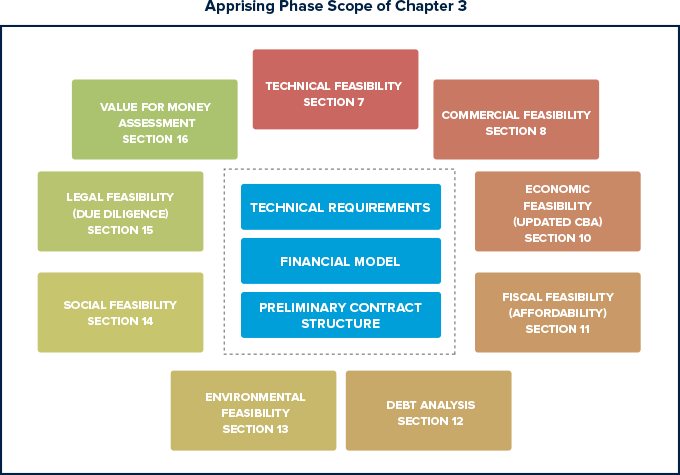5.1 Revenue Regime and Payment Mechanism
The revenue regime of PPPs refers to the source of revenues collected by the project company. This can be broadly divided into two major groups. The first is the user charges. The textbook examples are the tolls collected directly by the private partner in road concessions, or the fees paid to privately-operated metro trains. PPPs solely funded with user charges are known as user-pays PPPs.
5 Designing a Preliminary Structure of the PPP
One important aspect of the project, which needs to be preliminarily defined during appraisal, is the PPP contract structure, specifically in terms of the:
4.5 Outputs of Scoping the Contract and the Design of the Technical Requirements
The further detailing of the scope and the design of the technical requirements provides fundamental outputs for the Appraisal Phase and, indeed, for the whole of the PPP process, since it provides the technical description of the project used as a basis for other feasibility exercises. See box 4.2.
4.4 Estimating Risk-Adjusted Costs
Estimated risk-adjusted costs are a central output of the design of the technical requirements, and this data is used to feed the financial model. Depending on the type of infrastructure, the nature of this data can change. However, the typical sets of cost estimates that should be produced at this stage are as follows.
4.3 Consideration of Risk in the Appraisal Process
Chapter 5.6 provides a comprehensive overview of risk issues and the risk management cycle in PPP projects. During the appraisal process, risk identification and risk assessment are key tasks that provide inputs for constructing the financial base case for feasibility, for Value for Money (VfM) calculations, and for the initial consideration of risk allocation.
4.2 Designing the Technical Requirements
Technical requirements, together with other PPP structure parameters, lie at the heart of the contract. The technical requirements should provide enough technical details about the project so as to allow a precise definition of the design of the infrastructure (and the characteristics of the service) to be implemented, while avoiding being too prescriptive as explained below.
Through the technical requirements design process, costs are assessed, which are a key input for the commercial feasibility analysis explained further in this chapter.
4.1 Developing the Scope of the Contract
As introduced in chapter 3.6, the Identification Phase will likely have provided a basic scope of the contract, describing what elements of the technical solution selected for the public need will be delivered by the private partner under the PPP contract.
However, in some projects, defining the scope of the contract is not a simple matter. There are projects that may be developed and managed under different contract scopes, reserving certain obligations or services to other parties or to the public sector.
4 Detailing the Scope of the Contract, Designing the Technical Requirements and Assessing Costs
3 Overview of the Appraisal Phase/Process
The nature of the Appraisal Phase is intrinsically multidisciplinary. It consists of a series of intricate and interrelated exercises that detail the project, compare the project to a set of feasibility criteria, and prepare it for procurement (see figure 4.2).
FIGURE 4.2: Overview of the Appraisal Phase

2 Objectives of this Phase
Appraising a project means answering a fundamental set of questions about the project;

